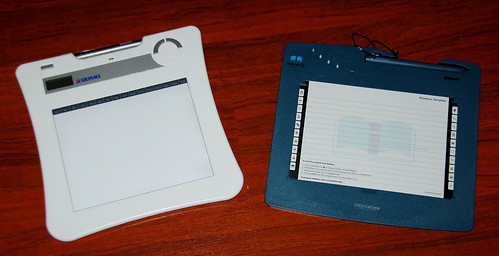I had an unusual package show up the other day. It was sent with no paperwork or warning, and came wrapped in plain brown paper. I was a bit hesitant to open it, but eventually worked up the nerve. Inside was a Qomo QIT30 Interactive Tablet (white, on the left above.) After a couple of phone calls and e-mails, I found out that it had been sent as part of a manufacturer’s promotion, giving these out to school administrators to test drive. I gave it a whirl, and decided to write up a review and comparison with the tablet we’ve already purchased for for many of our classrooms – the Interwrite Pad (blue, on right above.)
Both units have similar size, functionality, and price. Both come with white board and desktop software that let you annotate programs and use the unit like a mouse. However, there are some significant reasons for choosing one over the other for classroom use. I’ll start with the Qomo device.
First, the good stuff. The Qomo tablet has nice sleek lines and styling. There is an LCD screen to indicate connection and status. There are two thumb buttons to mimic right and left mouse buttons, and a series of programmable macro keys across the top of the pad. There is also a nice storage compartment to keep the RF dongle that attaches via USB. The Qomo is also pressure sensitive and has a high DPI resolution, so it functions like a graphics tablet, and is excellent for working with Photoshop and other art programs.
Now for the bad. It connects wirelessly via RF at 2.4 GHz. That’s a very crowded spectrum, and could cause conflicts with telephones and WiFi access points. I have to wonder how these might conflict with each other if you had a couple of them in adjacent classrooms. That shouldn’t be a problem, though, because you have rather limited range – about 60 ft.
The Interwrite Pad connects via Bluetooth, and purportedly has a much longer range. The Bluetooth connection eliminates possible interference with other units, so you could use multiple units in the same classroom. It isn’t touch sensitive like the Qomo, but it does have programmable macro keys. On the Interwrite keys, there are nice little icons that indicate the default function. There are none for the Qomo, but you can hover over the key and see its function on the screen. The Interwrite Pad doesn’t have a nice storage compartment for its dongle.
The Qomo’s stylus runs on a single AAA battery, and has a two-position rocker switch for right and left mouse functions. The right and left functions seem exactly opposite of what I think they should be, but they work well enough. The Interwrite Pad also has a similar rocker switch, but it’s stylus is rechargeable. However, I’ve had reports of units not working because the teacher didn’t line up the pen to charge in its cradle properly. A cord connects the stylus to the tablet on the Interwrite unit, but there is none for the Qomo unit.
Speaking of recharging, the Qomo only comes with a standard USB cable for recharging. The Interwrite Pad has a standard power block recharger. I could see a lot of our teachers being very frustrated trying to recharge the Qomo.
Probably, the clencher is that the Interwrite Pad is obviously designed for classroom use. There is a large collection of templates for classroom use, such as maps, manipulatives, and other graphics. There is also an extensive website offering lesson plans, etc. None of that exists for the Qomo unit. I guess you could use Interwrite’s software with the Qomo device, but why bother since they cost about the same? I guess I’m also bothered by the fact that the Qomo’s model number – QIT30 (I guess for “Qomo Interactive Table”) looks so much like the word “quit.”
If you have need of a touch sensitive device and are a bit more tech-savvy, the Qomo is for you. However, The Interwrite Pad is a much better choice for classroom use. I guess that’s why we’ve bought about 100 of them and none of the Qomos.
[tags]Interactive Tablet, classroom technology, instructional technology, Qomo QIT30, Interwrite Pad[/tags]
